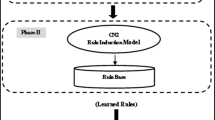Abstract
Terrorism has become one of the most tedious problems to deal with and a prominent threat to mankind. To enhance counter-terrorism, several research works are developing efficient and precise systems, data mining is not an exception. Immense data is floating in our lives, though the scarce availability of authentic terrorist attack data in the public domain makes it complicated to fight terrorism. This manuscript focuses on data mining classification techniques and discusses the role of United Nations in counter-terrorism. It analyzes the performance of classifiers such as Lazy Tree, Multilayer Perceptron, Multiclass and Naïve Bayes classifiers for observing the trends for terrorist attacks around the world. The database for experiment purpose is created from different public and open access sources for years 1970–2015 comprising of 156,772 reported attacks causing massive losses of lives and property. This work enumerates the losses occurred, trends in attack frequency and places more prone to it, by considering the attack responsibilities taken as evaluation class.
Access this chapter
Tax calculation will be finalised at checkout
Purchases are for personal use only
Similar content being viewed by others
References
Tolan GM, Soliman OS (2015) An experimental study of classification algorithms for terrorism prediction. Int J Knowl Eng 1:107–112. https://doi.org/10.7763/ijke.2015.v1.18
Malathi A, Santhosh Baboo S (2011) Evolving data mining algorithms on the prevailing crime trend – an intelligent crime prediction model. Int J Sci Eng Res 2
Sachan A, Roy D (2012) TGPM: terrorist group prediction model of counter terrorism. Int J Comput Appl 44(10):49–52
Thuraisingham B (2003) Data mining, national security, privacy and civil liberties. SIGKDD Explor 4(2):1–5
Kumar V, Zinovyev R, Verma A, Tiwari P (2018) Performance evaluation of lazy and decision tree classifier: a data mining approach for global celebrity’s death analysis. In: International conference on research in intelligent and computing in engineering (RICE). IEEE Xplore, pp 1–6. https://doi.org/10.1109/rice.2018.8509082
Bolz F et al (2001) The counterterrorism handbook: tactics, procedures, and techniques. CRC Press, Boca Raton
Ghosh A (1998) Ecommerce security: weak links and strong defenses. Wiley, New York
Thuraisingham B (2003) Web data mining technologies and their applications in business intelligence and counter-terrorism. CRC Press, Boca Raton
Hehenberger MR (2002) Text-based knowledge discovery: search and mining of life-science documents. Drug discovery today 7(11, Suppl):S89–S98
Navathe SB, Ramez E: Data warehousing and data mining. In: Fundamentals of database systems. Pearson Education Pvt Inc., Singapore, pp 841–872 (2000)
Michael WB (2004) Automatic discovery of similar words. In: Survey of text mining: clustering, classification and retrieval. Springer Verlag, New York, LLC, pp 24–43
Salvetti F, Lewis S, Reichenbach C (2004) Automatic opinion polarity classification of movie. Colo Res Linguist 17:2
Zhang D, Xu H, Su Z, Xu Y (2015) Chinese comments sentiment classification based on word2vec and SVM perf. Expert Syst Appl 42(4):1857–1863
Joachims T (2006) Training linear SVMs in linear time. In: Proceedings of the 12th ACM SIGKDD international conference on knowledge discovery and data mining. ACM, pp 217–226
Boger Z, Kuflik T, Shoval P, Shapira B (2001) Automatic keyword identification by artificial neural networks compared to manual identification by users of filtering systems. Inf Process Manag 37:187–198
Pierrea S, Kacanb C, Probstc W (2000) An agent-based approach for integrating user profile into a knowledge management process. Knowl-Based Syst 13:307–314
Provost F, Fawcett T (2001) Robust classification for imprecise environments. Mach Learn 42(3):203–231
Evfimievski A, Srikant R, Agrawal R, Gehrke J (2002) Privacy preserving mining of association rules. In: Proceedings of the eighth ACM SIGKDD international conference on knowledge discovery and data mining, Edmonton, Alberta, Canada
Kalpana R, Bansal KL (2014) A comparative study of data mining tools. Int J Adv Res Comput Sci Softw Eng 4:216–223
Kumar V, Tiwari P, Mishra BK, Kumar S (2017) Implementation of n-gram methodology for rotten tomatoes review dataset sentiment analysis. Int J Knowl Disc Bioinf (IJKDB) 7(1):30–41. https://doi.org/10.4018/ijkdb.2017010103
Kumar V, Verma A, Mittal N, Gromov SV (2019) Anatomy of preprocessing of big data for monolingual corpora paraphrase extraction: source language sentence selection. In: Emerging technologies in data mining and information security. Advances in intelligent systems and computing, vol 814. Springer Nature, Singapore, pp 495–505. https://doi.org/10.1007/978-981-13-1501-5_43
Kumar, V, Kalitin D, Tiwari, P (2017) Unsupervised learning dimensionality reduction algorithm PCA for face recognition. In: International conference on computing, communication and automation (ICCCA). IEEE Xplore, pp 32–37. https://doi.org/10.1109/ccaa.2017.8229826
Han J, Kamber M, Pei J (2012) Data mining concepts and techniques, 3rd edn. Morgan Kaufmann, Burlington
Author information
Authors and Affiliations
Corresponding author
Editor information
Editors and Affiliations
Rights and permissions
Copyright information
© 2020 Springer Nature Switzerland AG
About this paper
Cite this paper
Kumar, V., Mazzara, M., Messina, A., Lee, J. (2020). A Conjoint Application of Data Mining Techniques for Analysis of Global Terrorist Attacks. In: Ciancarini, P., Mazzara, M., Messina, A., Sillitti, A., Succi, G. (eds) Proceedings of 6th International Conference in Software Engineering for Defence Applications. SEDA 2018. Advances in Intelligent Systems and Computing, vol 925. Springer, Cham. https://doi.org/10.1007/978-3-030-14687-0_13
Download citation
DOI: https://doi.org/10.1007/978-3-030-14687-0_13
Published:
Publisher Name: Springer, Cham
Print ISBN: 978-3-030-14686-3
Online ISBN: 978-3-030-14687-0
eBook Packages: Intelligent Technologies and RoboticsIntelligent Technologies and Robotics (R0)




